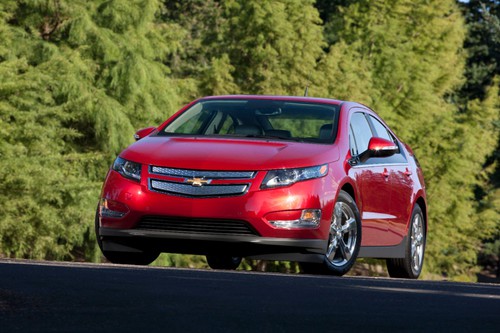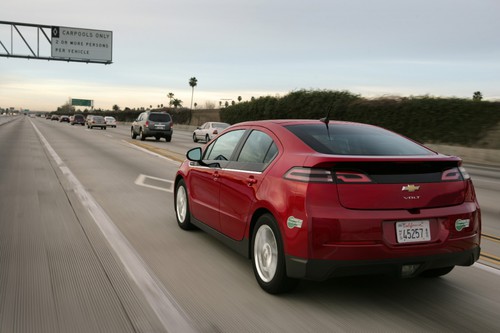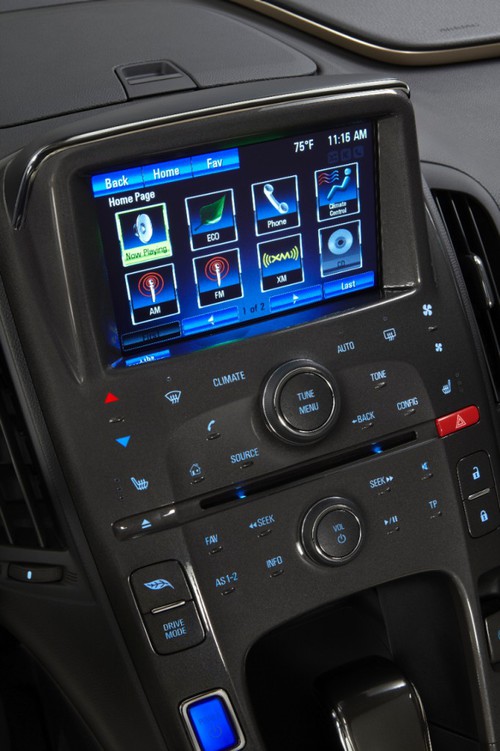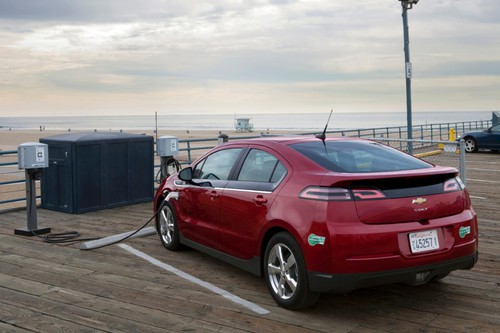The 2012 Chevy Volt began sales in late 2011. The 2013 Chevy Volt quietly began shipping in the summer of 2012.
The Chevy Volt is GM’s reentry into electric car manufacturing after the ill-fated decision to crush the EV1. It is technically a plug-in hybrid design, the EPA rates it as a plug-in hybrid, but GM’s marketing team invented the phrase “Extended Range Electric Vehicle” and there are many proponents arguing that the Volt should be classified as an electric car (with gasoline engine range extension). Whether or not it is an electric car is one of those nitpicking exercises that raises a smokescreen of unnecessary controversy.
The Volt is an excellent car and Volt owners are routinely driving for thousands of miles at a time without burning gasoline. This is testament to GM’s decision to size the battery pack so the Volt can handle the majority of daily driving. The majority of people drive less than 40 miles a day, and guess what the electric range of the Volt is 35-40 miles.
Voltec Drive train
The heart of the Chevrolet Volt is its Voltec propulsion system, which combines pure electric drive and an efficient, range-extending engine, giving the Volt up to 382 total miles (615 km) of range.
The Volt’s long-life battery consists of a 5.5-foot (1.6 m), 435-pound (198.1 kg) T-shaped, 16 kWh lithium-ion battery pack. It supplies energy to an advanced, 111-kW (149-hp) electric drive unit to propel the vehicle. Using only the energy stored in the battery, the Volt delivers an EPA-estimated 38 miles (61 km) of fuel- and tailpipe emissions-free electric driving, depending on terrain, driving techniques and temperature.
The Volt battery is covered by an eight-year/100,000-mile warranty. When the battery energy is depleted, the Volt seamlessly transitions to extended-range mode. Power is inverted from a technically advanced, 1.4L 84-hp (63-kW) gasoline-powered onboard engine to the electric drive unit to provide up to 344 (553 km) additional miles of range.
New features for 2013 model
- Increase in EPA-estimated EV range of three miles, to 38 miles
- Hold drive mode in addition to Normal, Sport and Mountain drive modes, allows owners to conserve battery charge for use in the most efficient manner
- Low-emissions package (e-AT-PZEV) makes Volt eligible for single-occupancy HOV-lane access in California and New York
- Body color roof and liftgate
- Pebble Beige premium cloth seats
- Pebble Beige leather-appointed seats with suede inserts
- Available audio system with GPS-based navigation, AM/FM/Sirius XM stereo with CD player and MP3 playback capability, navigation and USB port, seven-inch-diagonal touch-screen display and Radio Data System
- Removable rear center armrest with storage included in available Premium Trim Package
- Comfort Package includes heated driver and front passenger cloth seats and leather-wrapped steering wheel
- Available Safety Package 1 includes auto-dimming inside rearview mirror, rear park assist and rear vision camera
- Available Safety Package 2 includes front park assist, forward collision alert and lane departure warning systems
The Volt and HOV Access
In California (? and New York ?) there is a valuable perk available to “zero emissions car” owners. It is a sticker allowing access in the HOV lane. In California the program began in the late 90’s and was rationalized as fulfilling one of the goals of the HOV lanes: Cleaner air. The idea was to incentivize zero emissions car ownership by giving owners of those vehicles a little gift, the right to drive in the HOV lane and have better speed during commute times.
The popularity of the Prius came in part because that car qualified for the gold HOV sticker. The gold HOV sticker program ended in 2011. The owners of those Prius’s are looking for a new car to give them a magic HOV sticker.
The initial version of the Volt did not qualify for an HOV sticker, while the Nissan Leaf does qualify for a white HOV sticker. In early 2012 a version of the Volt became available which qualified for a new green HOV sticker. Once that Volt became available, the sales trend for the Leaf and Volt swapped places, with the Volt now outselling the Leaf.
Interior pictures
Specifications for the 2013 Volt
Overview
| Model: | 2013 Chevrolet Volt |
|---|---|
| Body style / driveline: | front-wheel-drive, five-door hatchback extended-range electric vehicle |
| Construction: | single body-frame-integral (unibody) with front and rear crumple zones; galvanized steel front fenders; hood, roof, door panels; one-piece bodyside outer panel; thermal plastic olefin (TPO) bumper fascias |
| EPA vehicle class: | compact car |
| Key competitors: | Nissan Leaf, Toyota Prius, clean diesels, mid-luxury sport sedans |
| Manufacturing location: | Detroit-Hamtramck Assembly, Hamtramck, Mich. |
| Battery manufacturing location: | Brownstown Township, Mich. |
Battery System |
|
| Type: | rechargeable energy storage system comprising multiple linked modules |
| Size/case: | 5.5-foot-long T-shaped; glass-filled polyester structural composite with aluminum thermal radiation shield and steel |
| Mass (lb / kg): | 435 / 198.1 |
| Battery chemistry: | lithium-ion |
| Thermal system: | liquid active thermal control |
| Cells: | 288 prismatic |
| Combined electric/extended driving range (miles / km): | Up to 382 miles / 615 km |
| Warranty: | eight years / 100,000 miles |
| Energy: | 16-kWh |
Engines |
|
| Type: | 1.4L DOHC I-4 |
| Displacement (cu in / cc): | 85.3 / 1398 |
| Bore & stroke (in / mm): | 2.89 x 3.25 / 73.4 x 82.6 |
| Block material: | cast iron |
| Cylinder head material: | cast aluminum |
| Valvetrain: | overhead camshafts; four valves per cylinder, continuously variable intake and exhaust cam phaser |
| Ignition system: | Individual coil-on-plug Ð cassette type |
| Fuel delivery: | sequential multi-port fuel injectors with electronic throttle control |
| Compression ratio: | 10.5:1 |
| Output (kW / hp @ rpm): | 63 / 84 @ 4800 |
| Max engine speed (rpm): | 4800 |
| Emissions controls: | close-coupled catalytic converters; 58x ignition system; returnless fuel rail; fast light-off O2 sensor |
| Fuel type: | premium required |
| EPA-estimated fuel economy (combined city / hwy): | 98 mpg-e all electric; 37 mpg gas only; 62 mpg-e combined composite |
Electric drive |
|
| Type: | electric, two-wheel, front-drive |
| Motors (two); | drive motor, 111 kW; generator motor, 55 kW |
| Transaxle: | Voltec electric drive system |
| Power (kW / hp): | 111 / 149 |
| Torque: (lb-ft / Nm): | 368 / 273 |
Charging time |
|
| 120 V: | about 10-16 hours (actual charge times may vary) |
| 240 V: | about 4 hours (actual charge times may vary) |
Performance |
|
| Top speed (mph): | 100 |
| EV range (city): | 38 miles (based on EPA estimated fuel economy) |
| EV / Extended range: | up to 382 miles including EV on fully charged battery and full tank of fuel |
Chassis / Suspension |
|
| Front: | independent MacPherson strut-type with side-loaded strut modules, specially tuned coil springs, direct-acting hollow stabilizer bar; hydraulic ride bushings |
| Rear: | specially adapted compound crank (torsion beam) with double-walled, U-shaped profile at the rear; specifically tuned coil springs, hydraulic bushings |
| Chassis control: | four-channel ABS; all-speed traction control; StabiliTrak; drag control |
| Steering type: | rack-mounted electric power steering with ZF steering gear |
| Steering wheel turns, lock-to-lock: | 2.8 |
| Turning circle, curb-to-curb (ft / m): | 36 / 11 |
| Steering ratio: | 15.36 |
Brakes |
|
| Type: | power four-wheel vented disc with ABS; electro-hydraulic; fully regenerative to maximize energy capture; dynamic rear brake proportioning |
| Brake rotor diameter front (mm / | 300 /11.8; vented, single 60-mm front / rear piston w/ steel body caliper |
| Brake rotor diameter rear (mm / in): | 292 / 11.5; vented; steel body caliper with single 38-mm piston |
| Total swept area (cu cm): | front: 498; rear: 362 |
Wheels / Tires |
|
| Wheel size and | 17 x 7-in. lightweight, five-spoke painted aluminum alloy (std.); 17 x 7-in. lightweight, five-spoke polished aluminum alloy (opt.); 17 x 7-in. lightweight, sport alloy with black inserts (opt) |
| Tires: | Goodyear Fuel Max 215/55R/17 low-rolling resistance BSW; all-season |
Exterior Dimensions |
|
| Wheelbase (in / mm): | 105.7 / 2685 |
| Overall length (in / mm): | 177.1 / 4498 |
| Overall width (in / mm): | 70.4 / 1788 |
| Track width front (in / mm): | 61.2 / 1554 |
| Track width rear (in / mm): | 62.1 / 1577 |
| Height (in / mm): | 56.6 / 1439 |
| Front overhang (in / mm): | 39.0 / 993 |
| Rear overhang (in / mm): | 32.2 / 820 |
Interior Dimensions |
|
| Seating capacity (front / rear): | 2 / 2 |
| Headroom (front / rear, in. / mm): | 37.8 / 960; 36.0 / 915 |
| Shoulder room (front / rear, in / mm): | 56.5 / 1436; 53.9 / 1369 |
| Hip room (front / rear, in / mm): | 53.7 / 1365; 51.2 / 1301 |
| Legroom (front / rear, in / mm): | 42.0 / 1068; 34.1 / 866 |
| Cargo volume (cu ft / L): | 10.6 / 300.2 |
Capacities |
|
| Curb weight (lb / kg); | 3781 / 1715 |
| Gross Vehicle Weight Rating (lb / kg): | 4583 / 2079 |
| Generator cooling (qt / L): | 7.7 / 7.3 |
| Battery pack cooling (qt / L): | 7.4 / 7.0 |
| Power electronics cooling (qt / L): | 3.1 / 2.9 |
| Fuel tank (gal / L): | 9.3 / 35.2 |
| Engine oil w/ filter (qt / L): | 3.7 / 3.5 |
| Drive unit fluid (qt / L): | 8.93 / 8.45 |
| Coefficient of drag (Cd): | 0.28 |












